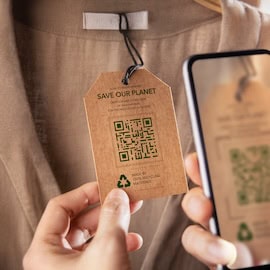“Get TF outa here” is a sanitised version of 80s’ film icon Axel Foley’s memorable line from Beverly Hills Cop — the third sequel of which was released on Netflix this summer, 30 years after the previous one. In one of the film’s most beloved scenes, Axel, played by Eddie Murphy, goes to an art gallery, and utters the phrase to express his deep scepticism about the worth of a piece of modern art.
His response comes to mind when assessing the current carbon emissions reporting landscape, which is awash in bold, often dubious claims about the supposed climate impact of different businesses. These claims are a result of the increasing pressure on companies from regulators, customers, investors, employees and trade unions to provide a greater degree of environmental accountability — that’s the reason you see “Made in a Net Zero Factory” printed on your cosmetics, for example. As businesses are forced to comply with ever more stringent regulations about the environmental impacts of their operations, the clearest marker of their sustainability lies in their emissions reporting. So they tend to go to great lengths to put their most favourable numbers forward in this reporting — often to the point of straining credulity.
However, reporting on emissions without verifiable evidence is worse than pointless — it is harmful. It effectively obscures the true nature of a business’ environmental footprint.
The Importance of Accurate Emissions Reporting
To understand the importance of accurate emissions reporting, it is worth a refresher on the three categories of emissions covered by ESG reporting: Scope 1, Scope 2 and Scope 3.
Scope 1 emissions are direct emissions from company-owned or controlled sources, such as factory smokestacks. Scope 2 emissions cover indirect emissions from the consumption of energy purchased and used by a company, e.g., electricity, heating and cooling. Since it uses this energy in its operations, a business is indirectly responsible for the release of these greenhouse gas emissions. So far, so simple. For Scope 1, it’s relatively trivial to calculate the emissions from a business process, since the company can measure all its inputs. For Scope 2, a company’s utility provider will tell it how much electricity it has used when they send the bill, so its indirect emissions can easily be estimated with a simple calculation.
But Scope 3 emissions are much more complex, as they encapsulate the environmental impact of a company’s entire supply chain. This includes everything from the mining of materials to the transportation and ultimate disposal of products. Unlike Scope 1 and 2, Scope 3 emissions require companies to look beyond their immediate operations and consider the practices of their suppliers and customers, who may operate in countries with less strict reporting regimes.
Taken to its logical conclusion, that means an oil company like BP must include the emissions from each customer’s petrol or diesel car — which in Axel’s case was a gas-guzzling red Mercedes convertible — in its Scope 3 emissions reporting. Unsurprisingly, that means these Scope 3 emissions usually constitute the largest segment of a company’s carbon footprint. However, it’s difficult to gather reliable data on these emissions, and without solid evidence, this reporting can be an exercise in greenwashing.
Currently, many companies rely on estimates and broad assumptions to report their Scope 3 emissions. The methodologies, metrics and assumptions they use vary widely, leading to inconsistencies and a lack of comparability. The error margins used in these estimates can multiply when considering the complex web of suppliers and partners involved in a typical business, leading to final numbers which may be inaccurate by orders of magnitude.
Addressing the Problem of Unreliable Emissions Data
Unreliable emissions data not only distorts the actual environmental impact of a business, it also makes it easier for companies to deliberately present an exaggeratedly positive picture of their sustainability efforts.
Transparency and accountability in emissions reporting are imperative, for good reason. Verifiable evidence builds trust with a company’s stakeholders, including investors, regulators and consumers. When these stakeholders can rely on the data presented in a business’ emissions report, they can make more informed decisions, leading to more effective environmental strategies. All this is well understood — yet the problem persists. So how do we ensure that Scope 3 emissions reporting is accurate?
It is not an impossible challenge — the technology exists to enable full supply chain visibility, thanks to blockchain. When they hear the word blockchain, most people think of cryptocurrency, but blockchain has uses far beyond speculation. It offers a means to ensure that data is accurate and verifiable purely due to the way it’s structured. By creating an immutable ledger of transactions, blockchain can track emissions throughout the supply chain with unprecedented precision.
Blockchain technology can effectively track emissions throughout the entire manufacturing process and product lifecycle, including consumer use, by leveraging its decentralised and immutable ledger capabilities. Sensors and Internet of Things (IoT) devices can collect real-time data on emissions at each stage of the manufacturing process, from raw material extraction to production, transportation and distribution. Automated agreements can ensure that data is recorded accurately and consistently at each step. Throughout the product’s lifespan, each transaction or data entry can be securely recorded on the blockchain, creating a tamper-proof history of emissions.
All stakeholders, including manufacturers, suppliers, distributors and consumers, can access this transparent and comprehensive emissions data. Digital product passports can provide detailed information about the product’s lifecycle emissions, including its use and disposal. Consumers can contribute data on product usage, which can then be added to the blockchain to complete the emissions profile. Independent auditors can verify the recorded emissions data, ensuring its accuracy and reliability. Companies can use this verified data to meet regulatory requirements and report on their sustainability efforts. This comprehensive approach can not only enhance transparency and accountability, it can also help companies and consumers make more informed decisions to reduce their environmental impact.
The Key Barriers to Blockchain-Based Emissions Reporting
Although this technological solution exists, there are several challenges preventing it from being widely implemented in emissions reporting. The biggest barriers at present are lack of coordination and slow adoption.
Industries need to collaborate to establish standards and share best practices, ideally across sectors as diverse as petrochemicals, pharmaceuticals and automobile manufacturing. Emissions reporting often involves multiple stages of a supply chain, from raw material extraction to manufacturing, distribution and retail. A single business can implement blockchain-based reporting for its own operations, but without collaboration, it won’t have access to the necessary data from its suppliers and partners. This interconnectedness means that for blockchain to be truly effective, all parties involved need to participate. For blockchain to work at optimum efficiency, the data entered must be consistent and standardised across the industry. If each business uses different formats or standards, it becomes challenging to integrate and verify the data. Blockchain’s strength lies in its ability to provide transparent and immutable records. When multiple businesses within an industry adopt blockchain, it enhances trust and accountability across the entire supply chain.
“Slow adoption” can sound circular and self-serving, but it is also a significant barrier. While a single business can start implementing blockchain, the full benefits are realised when there’s industry-wide collaboration. That’s because blockchain technology benefits from network effects, which help ensure data consistency, transparency and trust — meaning its value increases as more participants join. Slow adoption means fewer participants, which reduces the overall effectiveness and attractiveness of the technology. Additionally, early adopters often face higher costs and risks. So if adoption is slow, businesses may be hesitant to invest in blockchain technology due to uncertainty about its widespread acceptance and long-term viability. Slow adoption can also be due to regulatory hurdles and the lack of standardised practices across industries. These challenges need to be addressed collectively to create a conducive environment for blockchain adoption, paving the way for more consistent and reliable reporting across companies, public sector entities and NGOs.
In addition, stronger regulatory frameworks — which are already in gestation across the globe — and enforcement mechanisms are needed to ensure that emissions reporting is backed by immutable, trusted data. Such a regulatory and reporting environment will ensure that organisations cannot simply greenwash their way to a better public image. In short, organisations need to prove their green credentials. Blockchain-supported platforms allow them to do that. We need more companies to use blockchain to track their emissions and other environmental impacts, such as water and land use. We need to put nature on the balance sheet as an asset — in a measurable, trusted way.
The Emergence of Blockchain-Based Emissions Tracking
Leaders and forward-thinking companies recognise environmental, social and governance excellence as a competitive differentiator, including progress around their Scope 3 emissions. For example, capital-intensive companies like SABIC — a global petrochemicals manufacturer with an intricate supply chain — have begun using blockchain-backed tools to track the emissions generated by all the materials they use, from extraction to final product, while also tracking emissions from the consumer use and recycling of these products. Such transparency around emissions involved in the manufacture, use and recycling of products not only enhances their emissions reporting accuracy, it also improves their supply chain efficiency and accountability.
As the SABIC example demonstrates, with the right tools and the right attitude, accurate and verifiable Scope 3 reporting is attainable. As the benefits of blockchain technology for supply chains become clear — namely, reduced costs, time savings, and the positive climate impacts of moving these processes toward net zero — we will see more organisations follow in the footsteps of pioneering early adopters like SABIC. To make it easier for them to do so, Finboot’s blockchain-based technology provides green supply chain management for the world’s largest capital-intensive companies across their whole supply chain — including the customers who buy the companies’ products. Some of our clients include SABIC, energy providers CEPSA and REPSOL, and specialist steel industry player Gestamp.
Our work with SABIC demonstrates how we can track a product across production and use, and then through recycling and back to production again. The humble plastic yogurt pot made by SABIC for various yogurt manufacturers and retailers provides us with a good case study in how this works in reality, showing how blockchain technology can enhance supply chain transparency and sustainability. In November 2021 SABIC, in collaboration with Finboot, Plastic Energy and Intraplás, launched a pilot project to use blockchain to enable end-to-end digital traceability of the circular feedstock in their TRUCIRCLE products. The project used Finboot’s MARCO Track and Trace platform to record and verify each step of the product’s manufacturing and recycling processes on the blockchain, ensuring data integrity and transparency. This initiative not only supports SABIC’s sustainability goals, it also provides consumers with verifiable information about the recycled content of their packaging.
Tracing the journey of feedstock through the complex petrochemical value chain is currently a difficult undertaking, and SABIC’s pilot is the first of its kind in the industry to trace the product from feedstock production to product recycling, going further than previous industry applications of blockchain in end-to-end tracing. To make this tracking simpler, Finboot has created one of the first green supply chain management suites, with features that include integrated traceability, allowing companies to track their carbon emissions, automate digital product passports, create sustainability credits and facilitate compliance with environmental regulations in both the U.S. and E.U.
There are several noteworthy elements of our approach that are worth exploring in more detail. For instance, the automated digital product passports enabled by Finboot’s blockchain technology provide a comprehensive digital record for each product, capturing its entire lifecycle from raw materials to final disposal. Information about the product’s journey — including the acquisition of raw materials, manufacturing processes, energy usage and emissions — is collected and stored on the blockchain. Each step in the supply chain is recorded, ensuring that the data is transparent and tamper-proof, and enhancing traceability and accountability. The process of creating and updating these digital product passports — including generating sustainability declarations and compliance documents — is automated, reducing manual effort and errors. Through these passports, consumers and businesses can access detailed information about the product’s environmental impact, promoting informed decision-making and reducing greenwashing.
The creation of reliable sustainability credits is another benefit of Finboot’s approach. These credits are tradable certificates that represent a reduction in environmental impact, such as carbon emissions. They can be earned through various sustainable practices and projects, and can be traded or sold to other organisations looking to offset their own environmental footprint. Carbon credits are the most common type of sustainability credits, with each credit representing the reduction or removal of one metric tonne of carbon dioxide or equivalent greenhouse gasses from the atmosphere. For instance, projects focused on reforestation, renewable energy installations or energy efficiency improvements can generate carbon credits, through activities that range from planting trees to installing solar panels. The project’s impact is verified by an independent third party to ensure that the claimed reductions are real and measurable. Once verified, the project is issued carbon credits, which can then be traded on the market. By purchasing these credits, companies and other organisations can help meet their regulatory requirements or achieve voluntary sustainability goals. This evolving system provides financial incentives for sustainable practices, supports environmental projects and helps companies reduce their overall carbon footprint — but its effectiveness hinges on the verifiability of the credits being traded.
If they hope to make real progress toward reducing their carbon emissions, businesses need to redesign their operational processes to place emissions data at the centre. This is particularly true in the capital-intensive industries like energy, steel, chemical production and mineral extraction that must decarbonise if the world is to get to net-zero. In the words of management thinker Peter Drucker, “You can’t manage what you can’t measure.” It’s about time businesses started measuring their Scope 3 emissions properly as a key initial step — otherwise, customers, regulators and the broader public are likely to greet their future emissions reports with the same scepticism as Axel Foley in a modern art gallery.
Note: Finboot is backed by SABIC and is headquartered in the UK, with a base in Barcelona.
Nish Kotecha is the Executive Chair and Co-Founder of Finboot.
Photo courtesy of Adobe Stock Photos.
Publisher: Source link






